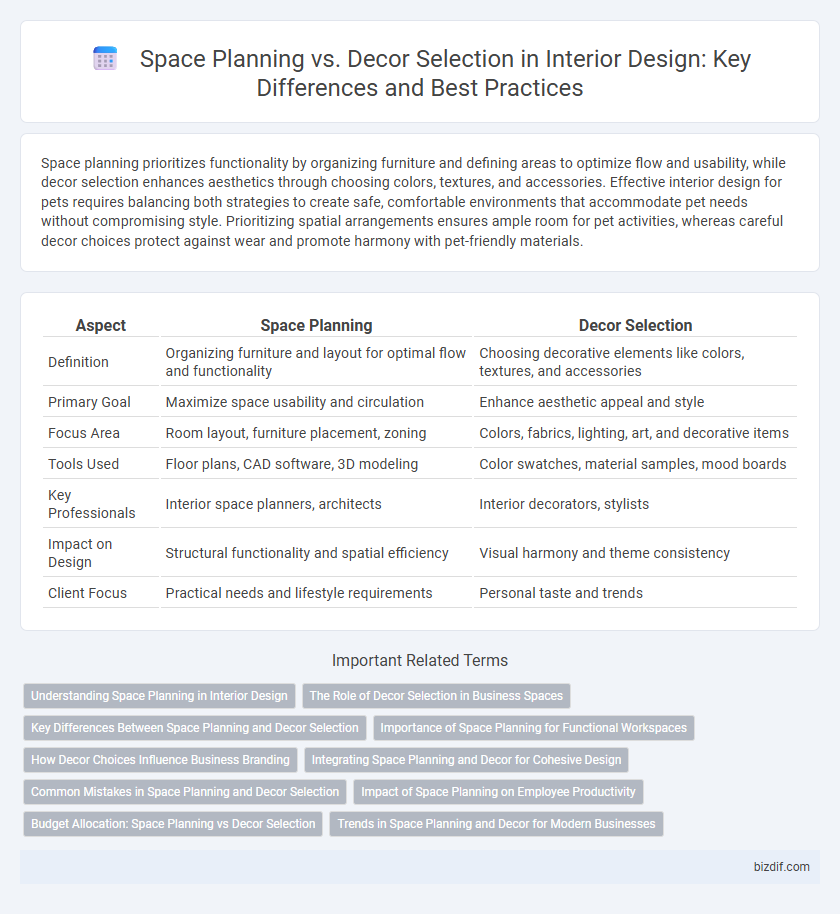Space planning prioritizes functionality by organizing furniture and defining areas to optimize flow and usability, while decor selection enhances aesthetics through choosing colors, textures, and accessories. Effective interior design for pets requires balancing both strategies to create safe, comfortable environments that accommodate pet needs without compromising style. Prioritizing spatial arrangements ensures ample room for pet activities, whereas careful decor choices protect against wear and promote harmony with pet-friendly materials.
Table of Comparison
| Aspect | Space Planning | Decor Selection |
|---|---|---|
| Definition | Organizing furniture and layout for optimal flow and functionality | Choosing decorative elements like colors, textures, and accessories |
| Primary Goal | Maximize space usability and circulation | Enhance aesthetic appeal and style |
| Focus Area | Room layout, furniture placement, zoning | Colors, fabrics, lighting, art, and decorative items |
| Tools Used | Floor plans, CAD software, 3D modeling | Color swatches, material samples, mood boards |
| Key Professionals | Interior space planners, architects | Interior decorators, stylists |
| Impact on Design | Structural functionality and spatial efficiency | Visual harmony and theme consistency |
| Client Focus | Practical needs and lifestyle requirements | Personal taste and trends |
Understanding Space Planning in Interior Design
Space planning in interior design involves the strategic arrangement of furniture and functional zones to optimize flow, utility, and comfort within a room. It prioritizes spatial relationships, traffic patterns, and ergonomic considerations to create cohesive environments that meet user needs. Effective space planning serves as the foundation for decor selection, ensuring aesthetic choices complement the room's purpose and layout.
The Role of Decor Selection in Business Spaces
Decor selection plays a crucial role in business spaces by enhancing brand identity and creating an inviting atmosphere that boosts employee productivity and customer engagement. Thoughtful choice of furniture, color schemes, and accessories complements space planning by adding personality and functional aesthetics tailored to the company's mission. Effective decor helps establish a professional environment that supports workflow efficiency while reflecting corporate culture.
Key Differences Between Space Planning and Decor Selection
Space planning involves the strategic arrangement of furniture and layout to optimize functionality and flow in a space, focusing on spatial dimensions, traffic patterns, and usability. Decor selection centers on choosing aesthetic elements such as color schemes, textures, accessories, and furnishings to enhance the visual appeal and ambiance. The key difference lies in space planning prioritizing spatial efficiency and practical use, while decor selection emphasizes style and personalized expression.
Importance of Space Planning for Functional Workspaces
Space planning is essential for creating functional workspaces by efficiently organizing furniture, equipment, and pathways to enhance productivity and comfort. It optimizes spatial flow and ensures that work areas meet ergonomic standards, reducing clutter and distractions. Unlike decor selection, which focuses on aesthetics, space planning prioritizes usability and effective allocation of resources for practical daily operations.
How Decor Choices Influence Business Branding
Decor choices directly impact business branding by creating a visual identity that resonates with target customers and reinforces brand values. Strategic selection of colors, textures, and furnishings enhances the ambiance, making the space memorable and supporting marketing goals. Effective space planning integrates decor elements to optimize customer experience and strengthen brand recognition in competitive markets.
Integrating Space Planning and Decor for Cohesive Design
Integrating space planning and decor selection creates a cohesive interior design by ensuring functional layouts complement aesthetic choices, optimizing both form and function. Space planning focuses on efficient spatial arrangements, while decor selection enhances style and ambiance, together transforming interiors into balanced, practical environments. Prioritizing seamless coordination between these elements improves flow, usability, and visual harmony in residential or commercial projects.
Common Mistakes in Space Planning and Decor Selection
Common mistakes in space planning include overcrowding furniture, neglecting traffic flow, and ignoring scale or proportion, which can lead to impractical and uncomfortable interiors. In decor selection, errors often involve choosing mismatched colors, ignoring lighting effects, and over-accessorizing, resulting in a cluttered or visually disjointed space. Prioritizing functional layout and cohesive decor enhances both usability and aesthetic appeal, avoiding these common pitfalls.
Impact of Space Planning on Employee Productivity
Efficient space planning in interior design directly enhances employee productivity by creating functional layouts that minimize distractions and promote smooth workflow. Thoughtful allocation of work zones and collaborative areas boosts communication and reduces downtime, optimizing overall performance. Strategic arrangement of furniture and equipment supports ergonomic well-being, leading to increased focus and job satisfaction.
Budget Allocation: Space Planning vs Decor Selection
Effective budget allocation in interior design prioritizes space planning, as it ensures optimal functionality and flow within a given area, directly impacting the overall usability of the space. Allocating funds primarily to space planning reduces costly changes during implementation by accurately mapping furniture placement, traffic patterns, and zoning. Decor selection, while essential for aesthetic appeal, typically demands a smaller portion of the budget and should complement the foundational layout established through space planning for a balanced and cost-efficient interior design project.
Trends in Space Planning and Decor for Modern Businesses
Modern businesses prioritize space planning that maximizes functionality and promotes collaboration, incorporating trends like flexible workstations, open layouts, and biophilic elements to enhance employee well-being and productivity. Decor selection emphasizes minimalistic designs, sustainable materials, and technology-integrated furnishings that align with the brand's identity and create an inviting atmosphere. Cutting-edge trends also include adaptive lighting systems and acoustic solutions that support diverse work styles and improve overall office ambiance.
Space Planning vs Decor Selection Infographic

 bizdif.com
bizdif.com